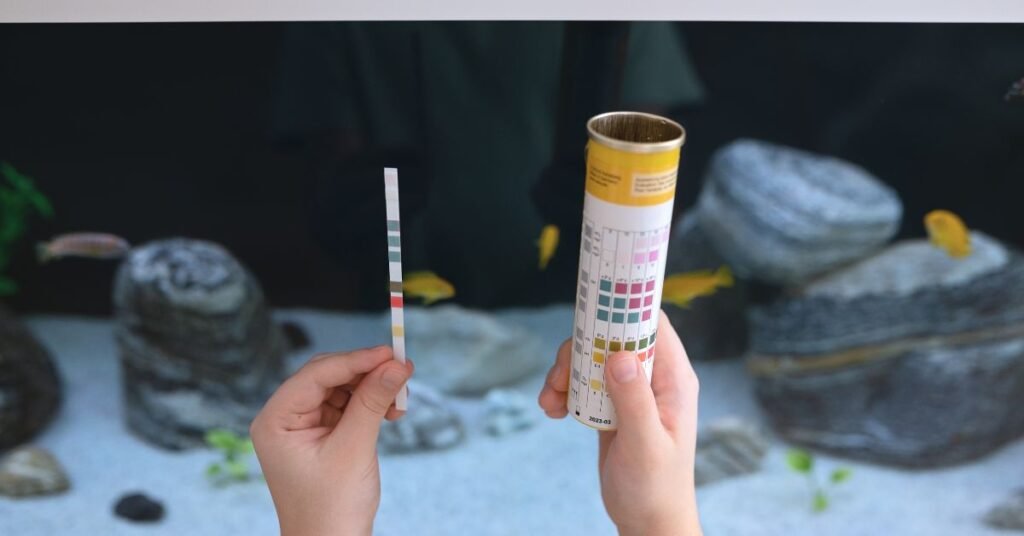Aquariums are home to many beautiful fish and other aquatic creatures. To keep them healthy and thriving, it is important to maintain good water quality. Another factor that is commonly measured in a water quality analysis is the pH level of the water. The pH levels indicate the concentration of acids or alkalis of the water. Most fish and aquatic creatures prefer a slightly acidic to neutral water pH, between 6.5 and 8.5. If the pH level is too low, it can stress and even harm your fish. Raising the pH level in your aquarium can be a challenging task, but it’s crucial for the health and well-being of your aquatic friends. In this article, we will explore easy and safe ways to Raise pH in an Aquarium. We will discuss the causes of low pH levels and provide simple and effective solutions. By following these tips, you can create a healthy and thriving environment for your fish and other aquatic creatures.

Causes of Low pH Levels in Aquariums
Many factors can cause low pH levels in aquariums. One common cause is the decay of organic matter, such as fish waste and leftover food.
As these materials break down, they release acidic compounds that lower the pH level. Another cause is the use of peat moss in the aquarium filter, which can release acidic substances into the water.
Overstocking the aquarium with too many fish can also lead to low pH levels, as the fish produce more waste than the filter can handle.
Poor water circulation and inadequate water changes can also contribute to low pH levels.
Some aquarium decorations, such as driftwood or certain types of rocks, can release acidic substances into the water.
A water conditioner not designed for aquariums can also lower the pH level. Furthermore, not monitoring and testing the pH level regularly can lead to unexpected drops in pH.

How to Raise pH in an Aquarium Simple Methods
Method 1: Water Changes
Remove 25% of the water from your aquarium and replace it with fresh water that has a higher pH level. This is a simple and safe way to raise the pH level.
Method 2: pH Buffers
Add crushed coral or shells to your aquarium. These natural materials release alkaline substances that help neutralize acidity. This is a gentle and non-toxic way to raise the pH level.
Method 3: Commercial pH Increasers
Use a commercial product specifically designed to raise pH levels. Follow the instructions and recommended dosage carefully. Be cautious not to overdo it, as this can harm your fish.
Method 4: Addressing Underlying Causes
Identify and address the underlying cause of the low pH level. Check for overstocking, poor water circulation, and inadequate filtration. Regular water changes, proper filtration, and monitoring the pH level regularly can help maintain a healthy pH level for your fish.

How Do Crushed Corals and Shells Work?
When you add crushed corals or shells to your aquarium, they slowly release calcium carbonate into the water. This helps neutralize the acidity in the water, raising the pH level. The calcium carbonate also provides essential minerals for your fish and other aquatic creatures.
Using Crushed Corals or Shells to Raise the pH
1. Choose the right amount: Start with a small amount, about 1-2 cups of crushed corals or shells for every 10 gallons of water.
2. Add them to the filter: Place the crushed corals or shells in your aquarium filter or in a media bag.
3. Monitor the pH level: Keep an eye on the pH level and adjust the amount of crushed corals or shells as needed.
Common pH Testing Methods and Tools
pH Test Strips
pH test strips are small paper strips that change color based on the pH level of the water. They are easy to use and always provide quick solutions.
How to use:
1. Dip the strip into the water for a few seconds.
2. Compare the color of the strip to the chart provided.
3. Determine the pH level based on the color.

pH Test Kits
pH test kits are a bit more advanced than test strips. They usually include a solution that changes color based on the pH level, and a chart to determine the pH level.
How to use:
1. Fill a small container with water from your aquarium.
2. Add a few drops of the solution to the water.
3. Compare the color of the solution to the chart provided.
4. Determine the pH level based on the color.

pH Meters
pH meters are electronic devices that measure the pH level accurately. They are a bit more expensive than test strips and kits but provide precise results.
How to use:
1. Dip the meter’s probe into the water.
2. Wait for a few seconds until the reading stabilizes.
3. Read the pH level on the meter’s display.

Tips for Maintaining Stable pH Levels
Maintaining stable pH levels in your aquarium is important for the health and well-being of your fish and other aquatic creatures.
1. Regular Water Changes
Regular water changes help remove acidic or basic substances that can affect the pH level. Change about 25% of the water every week to keep the pH level stable.
2. Monitor pH Levels Regularly
Test the pH level regularly using a pH test kit or pH meter. This helps you detect any changes in the pH level and make adjustments before it’s too late.
3. Use a pH Buffer
A pH buffer helps keep the pH level stable by neutralizing any acidic or basic substances that enter the water. You can use crushed corals or shells as a natural pH buffer.

4. Avoid Overstocking
Overstocking your aquarium can lead to a buildup of waste, which can lower the pH level. Make sure to leave enough space for your fish and other aquatic creatures.
5. Provide Good Filtration
Good filtration helps remove waste and excess nutrients that can affect the pH level. Make sure your filter is working properly and replace it as needed.
6. Avoid Sudden Changes
Sudden changes in water temperature, water chemistry, or lighting can affect the pH level. Make changes gradually to give your fish and other aquatic creatures time to adjust.
7. Use a Stable Water Source
Use a stable water source, such as a water conditioner, to remove chlorine and chloramines that can affect the pH level.

Conclusion
Raising the pH level in your aquarium is important for your fish’s health. Low pH levels can be harmful to your fish. But don’t worry, raising the pH level is easy! You can do it with simple and safe methods. Water changes, pH buffers, and commercial pH increasers are all good options. Remember to always test the pH level regularly. This way, you know if any changes need to be made to the adjustments. Make sure to address the underlying cause of low pH levels. This could be overstocking or poor water circulation.
Following these tips lets you keep your aquarium water at a healthy pH level. Your fish will thank you. The most suitable pH level is within the range of 6. 5 and 8. 5. Keep your aquarium water in this range. Raising the pH level is simple and easy. Just remember to be patient and make gradual changes. With a little care, your aquarium will be a happy and healthy home for your fish.

FAQ’s
Q1: Why do I need to raise the pH level in my aquarium?
You need to raise the pH level if it’s too low, as this can harm your fish. Most fish prefer a pH level between 6.5 and 8.5.
Q2: How often should I test the pH level in my aquarium?
You should test the pH level regularly, at least once a week, to make sure it’s within the safe range for your fish.
Q3: Can I use any type of water to raise the pH level in my aquarium?
No, you should use water that is specifically designed for aquariums and has a higher pH level than your tank water.
Q4: How long does it take to raise the pH level in my aquarium?
It depends on the method you use and the size of your tank. Water changes and pH buffers can take a few days to a week, while commercial pH increasers can take a few hours to a day. Always monitor the pH level and make gradual changes to avoid sudden changes that can harm your fish.
Also Must Read More: Unique Methods – How to add Oxygen to Fish Tank Fast